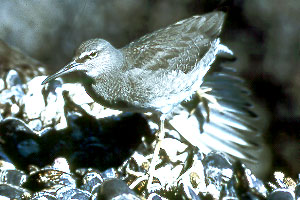
As optics continue to improve, characters formerly used only to identify birds in the hand or museum tray have been resurrected as useful field marks. In fact, I recall an advertisement for Questar in one of the birding magazines which touted the fact that you could see the nasal groove on a tattler at 100 paces. The truth is that you can barely see the nasal groove on a tattler in the hand. There has been a lot of confusion on this point and we had at least one major California tattler scare caused by an uncritical misunderstanding of the true nature of the nasal groove.
This groove is very narrow and runs down the side of the maxilla from the distal point of the nostril toward the tip. It is not the nostril itself which looks a lot like a "groove" if you don't think about it too much. The actual groove is barely visible at its base and becomes decidedly narrower and shallower towards the tip where it is no more than a hairline that can be accurately judged only by touch or a hand lens. This juvenile Wandering Tattler photographed in Marin County by Ian Tate is about as close a view as one is likely to get. I think many people might judge the nasal groove as "short" resulting in an incorrect identification. I mistrust any claims of Gray-tailed Tattler where the nasal groove is used to clinch the identification. After trying to use the nasal groove in museum specimens I have concluded that other characters are much better. See the public discussion for details.
I certainly applaud the advances in field identification that have come with the new great optics and the translation of "in-hand" characters into the field. Some would say that there is no such thing as a character that can be seen only in the hand and not in the field. In general I agree with that idea with one important exception. That exception is the nasal groove on a tattler.
I should never have called the owl "easy." I think that discouraged more people from contributing. Combined with everybody being mad at me for last month's Orange-crowned Warbler fiasco, we had the fewest public comments in any month since I started these photo quizzes. It's not much fun unless people post their thoughts. This is all supposed to be educational but it's also supposed to be fun. Nobody cares whose wrong or right and half the time I don't even know what these birds are. So please don't be afraid to make guesses, suggestions or wild speculation. I'd like to continue this feature, but it needs your support via public posts if it's going to work.
The owl was not as easy as I said. It is a Long-eared. However, it is in such a relaxed posture that it greatly resembles Great Horned in jizz. In particular the ear-tufts appear to be relaxed and far apart and the whole bird has a lumpy appearance instead of the thin stick-like appearance we usually associate with Long-eared. Originally I had looked at the photo only casually when I accessioned it into my teaching collection and mislabeled it "Great Horned."
The face pattern is critical. Note the dark vertical line intercepting the eye, and the facial disk is decidedly higher than it is wide. These are both diagnostic for Long-eared. The wing is slightly spread and you can see the rich buff patch at the base of the primaries, marked with black cross-bars. This patch is usually only visible only in flight and is very similar to the wing pattern of Short-eared Owl. In fact Long-eared and Short-eared owls are easy to confuse in flight, especially if one doesn't have a lot of experience with flying Long-eareds. Too many observers associate the buffy carpal patch only with Short-eared.
The intended take-home polemic of this mystery bird is that concrete field marks are much better than jizz when analyzing unknowns, particularly in photographs.
The original quiz is below:
What do you think these birds are? Please click here to view comments or add your own. Thanks.